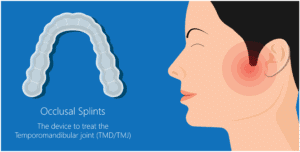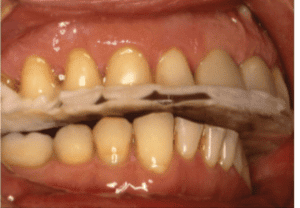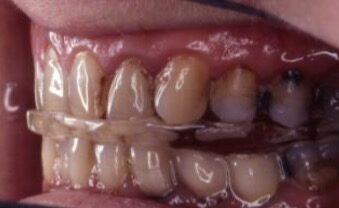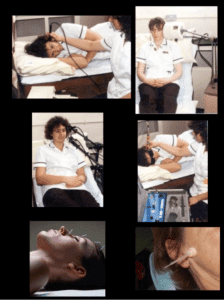SPLINT THERAPY
You can click on each treatment to learn more about it.
 WHAT IS IT USED FOR?
The occlusal bite splint should help to reduce tension in the jaw muscles, decrease painful symptoms, protect the teeth, and/ or maintain your jaw in a particular position.
This splint aims to provide comfortable contact between your opposing teeth and the surface of the splint. This might be to help your jaw muscles relax, to encourage you to stop grinding or clenching your teeth, or to ‘balance’ your bite.
WHAT IS IT USED FOR?
The occlusal bite splint should help to reduce tension in the jaw muscles, decrease painful symptoms, protect the teeth, and/ or maintain your jaw in a particular position.
This splint aims to provide comfortable contact between your opposing teeth and the surface of the splint. This might be to help your jaw muscles relax, to encourage you to stop grinding or clenching your teeth, or to ‘balance’ your bite. WHEN SHOULD I WEAR THE SPLINT?
Usually, you will need to wear this splint only at night, but you should follow the advice of the clinician who is looking after you.HOW LONG SHOULD I WEAR THE SPLINT FOR?
We find that after successful splint therapy most people can be ‘weaned’ off their splint and we will advise you about this on an individual basis. This is usually after 3 months of treatment. USE AND CARE OF OCCLUSAL BITE SPLINT?
USE AND CARE OF OCCLUSAL BITE SPLINT?
When you are not wearing your splint remember to keep it in a damp tissue or store it in water.
Clean your splint with toothpaste and a toothbrush. You can soak it in a dilute solution of Milton for a few hours once a week if necessary. Do not use anything hot to clean it (i.e. boiling water). FOLLOW UP
We need to review your progress at regular intervals, and also adjust the splint as needed. WHAT IS IT USED FOR?
WHAT IS IT USED FOR?
This splint aims to maintain your jaw in a particular position in which there is no click when you open and close your mouth.  WHEN SHOULD I WEAR THE SPLINT?
WHEN SHOULD I WEAR THE SPLINT?
You must wear your splint 24 hours a day, including when eating. HOW LONG SHOULD I WEAR THE SPLINT FOR?
Until becoming symptom free, (normally after 12 weeks of splint therapy).USE AND CARE OF OCCLUSAL BITE SPLINT?
If your jaw should lock (i.e. you cannot open your mouth very wide) leave the splint out until your next appointment. After becoming symptom free, you will then be advised about how to wean off splint therapy slowly. Your clinician will advise you on the best regimen for you.FOLLOW UP
Regular check-ups should be made to check the adjustment and fit of your splint.Other modalities
 WHAT IS IT?
WHAT IS IT?
Physiotherapy started early in the course of any musculo-skeletal disorder significantly reduces the duration of symptoms. This treatment option is beneficial to any TMD patient when there is muscle involvement.WHAT DOES THIS TREATMENT INVOLVE?
Physiotherapy can take the form of electrophysiotherapy such as megapulse ultrasound, soft laser, acupuncture or manipulation of the muscles and mobilisation of the joints.WHAT IS THE FREQUENCY OF TREATMENT?
The ideal frequency of appointments is two to three times a week for 3–4 weeks, totalling 8–10 sessions.
Facial Pain & TMD Treatment With Dr Ziad
If you’re looking for relief from jaw joint or facial pain in Edinburgh, meet Dr Ziad Al-Ani. An associate dentist, Dr. Ziad is passionate about the management of Temporomandibular Disorders (TMD) and facial pain by adopting numerous conservative non-surgical evidence-based treatments. These treatments include a wide range of splint therapy, pharmacological, occlusal alteration, and physiotherapeutic treatments mainly aiming at the reduction of pain and improving oral function.

 USE AND CARE OF OCCLUSAL BITE SPLINT?
USE AND CARE OF OCCLUSAL BITE SPLINT? WHAT IS IT USED FOR?
WHAT IS IT USED FOR? WHEN SHOULD I WEAR THE SPLINT?
WHEN SHOULD I WEAR THE SPLINT? WHAT IS IT?
WHAT IS IT?